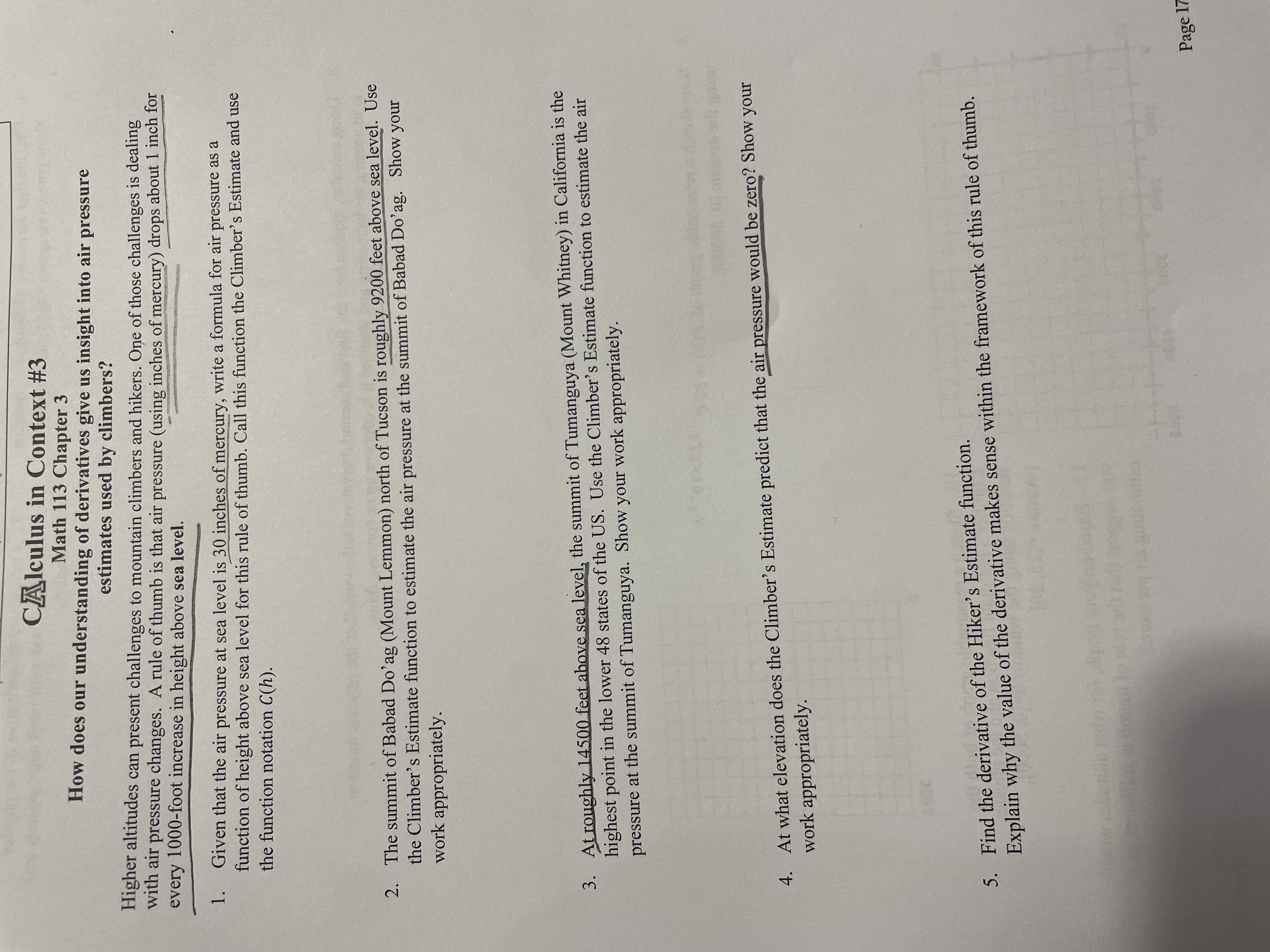
Calculus: Early Transcendentals
8th Edition
ISBN: 9781285741550
Author: James Stewart
Publisher: Cengage Learning
expand_more
expand_more
format_list_bulleted
Question

Transcribed Image Text:CAlculus in Context #3
Math 113 Chapter 3
How does our understanding of derivatives give us insight into air pressure
estimates used by climbers?
Higher altitudes can present challenges to mountain climbers and hikers. One of those challenges is dealing
with air
pressure changes. A rule of thumb is that air pressure (using inches of mercury) drops about 1 inch for
every 1000-foot increase in height above sea level.
1.
Given that the air pressure at sea level is 30 inches of mercury, write a formula for air pressure as a
function of height above sea level for this rule of thumb. Call this function the Climber's Estimate and use
the function notation C(h).
2. The summit of Babad Do'ag (Mount Lemmon) north of Tucson is roughly 9200 feet above sea level. Use
the Climber's Estimate function to estimate the air pressure at the summit of Babad Do'ag. Show your
work appropriately.
3. At roughly 14500 feet above sea level, the summit of Tumanguya (Mount Whitney) in California is the
highest point in the lower 48 states of the US. Use the Climber's Estimate function to estimate the air
pressure at the summit of Tumanguya. Show your work appropriately.
4. At what elevation does the Climber's Estimate predict that the air pressure would be zero? Show your
work appropriately.
5. Find the derivative of the Hiker's Estimate function.
Explain why the value of the derivative makes sense within the framework of this rule of thumb.
by
Page 17
Expert Solution
This question has been solved!
Explore an expertly crafted, step-by-step solution for a thorough understanding of key concepts.
This is a popular solution
Trending nowThis is a popular solution!
Step by stepSolved in 4 steps

Follow-up Questions
Read through expert solutions to related follow-up questions below.
Follow-up Question
What is the function. Is it 30 - (1/1000)x
Solution
by Bartleby Expert
Follow-up Questions
Read through expert solutions to related follow-up questions below.
Follow-up Question
What is the function. Is it 30 - (1/1000)x
Solution
by Bartleby Expert
Knowledge Booster
Similar questions
- Question 7. (AQA June 2005 Intermediate Paper 1 NO Calculator) The diagram shows a cylinder, The diameter of the cylinder is 10 cm. The height of the cylinder is 10 cm. (a) Calculate the volume of the cylinder. Give your answer in terms of T. 10 cm TIX5 x10 = 50 T -10 cm T0OS ado [3 marks] Twenty of the cylinders are packed in a box of height 10cm. The diagram shows how the cylinders are arranged inside the box. The shaded area is the space between the cylinders. (b) Work out the volume inside the box that is not filled by the cylinders. Give your answer in terms of n. Not drawn accurately [4 marks]arrow_forwardQuestions 2-5. Consider the data in the table. Time Value Absolute Change Relative Change Percent Increase |0 13.60 XX XX XX 1 14.85 2 16.10 3 17.35 |4 18.60 19.85 Complete the table by computing the absolute and relative change.arrow_forwardQuestions 6-9. Consider the data in the table. Absolute Relative Percent |Change Change Increase Time Value 13.60 17.00 2 21.25 3 26.56 |4 33.20 41.50 Which model would better represent this data, linear or exponential? Why? An exponential model would be better because the relative change is constant. A linear model would be better because the relative change is constant. A linear model would be better because the absolute change varies. An exponential model would be better because the absolute change is constant.arrow_forward
arrow_back_ios
arrow_forward_ios
Recommended textbooks for you
 Calculus: Early TranscendentalsCalculusISBN:9781285741550Author:James StewartPublisher:Cengage Learning
Calculus: Early TranscendentalsCalculusISBN:9781285741550Author:James StewartPublisher:Cengage Learning Thomas' Calculus (14th Edition)CalculusISBN:9780134438986Author:Joel R. Hass, Christopher E. Heil, Maurice D. WeirPublisher:PEARSON
Thomas' Calculus (14th Edition)CalculusISBN:9780134438986Author:Joel R. Hass, Christopher E. Heil, Maurice D. WeirPublisher:PEARSON Calculus: Early Transcendentals (3rd Edition)CalculusISBN:9780134763644Author:William L. Briggs, Lyle Cochran, Bernard Gillett, Eric SchulzPublisher:PEARSON
Calculus: Early Transcendentals (3rd Edition)CalculusISBN:9780134763644Author:William L. Briggs, Lyle Cochran, Bernard Gillett, Eric SchulzPublisher:PEARSON Calculus: Early TranscendentalsCalculusISBN:9781319050740Author:Jon Rogawski, Colin Adams, Robert FranzosaPublisher:W. H. Freeman
Calculus: Early TranscendentalsCalculusISBN:9781319050740Author:Jon Rogawski, Colin Adams, Robert FranzosaPublisher:W. H. Freeman
 Calculus: Early Transcendental FunctionsCalculusISBN:9781337552516Author:Ron Larson, Bruce H. EdwardsPublisher:Cengage Learning
Calculus: Early Transcendental FunctionsCalculusISBN:9781337552516Author:Ron Larson, Bruce H. EdwardsPublisher:Cengage Learning

Calculus: Early Transcendentals
Calculus
ISBN:9781285741550
Author:James Stewart
Publisher:Cengage Learning

Thomas' Calculus (14th Edition)
Calculus
ISBN:9780134438986
Author:Joel R. Hass, Christopher E. Heil, Maurice D. Weir
Publisher:PEARSON

Calculus: Early Transcendentals (3rd Edition)
Calculus
ISBN:9780134763644
Author:William L. Briggs, Lyle Cochran, Bernard Gillett, Eric Schulz
Publisher:PEARSON

Calculus: Early Transcendentals
Calculus
ISBN:9781319050740
Author:Jon Rogawski, Colin Adams, Robert Franzosa
Publisher:W. H. Freeman


Calculus: Early Transcendental Functions
Calculus
ISBN:9781337552516
Author:Ron Larson, Bruce H. Edwards
Publisher:Cengage Learning